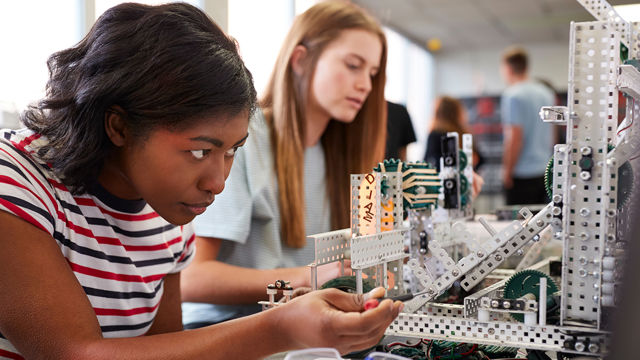
Digital skills for life: Girls in ICT Day
26 April 2023
This year’s Girls in ICT Day (27 April) focuses on the importance of ‘Digital skills for life’. These essential digital skills are key to help girls and young women excel in science, technology, engineering, and mathematics (STEM) education and careers. The following blog will highlight the importance of having more female representation in STEM, the barriers they face, and what can be done to overcome them.
Why does STEM need more women?
STEM subjects shape our everyday lives: they produce the devices we use, the development of vital medical treatments, huge engineering projects, and so much more. Having a higher number of women working in the sector means opinions and ideas of all genders shape the final product.
The percentage of female graduates with core STEM degrees is steadily growing, however the split is still 26%.[1] This figure is reflected in the female STEM workforce, with women making up only 24%.[2]

What barriers do women face?
Although female representation in STEM education and careers has increased since the 1970s, progress has plateaued in recent years. Computer sciences, for example, is the largest growing STEM field, yet the number of women working in computing dropped seven percent from 2000 to 2016 and has remained stable since that year.[3]
Stereotypes about women’s technological ability start early, often undermining their confidence in STEM related skills at as young as three or four years old. Negative stereotypes depict STEM subjects as ‘nerdy’, ‘difficult’, or ‘just for boys’.
Because of this, young girls often opt out of STEM related courses in early, further, and higher education, despite having the same potential as their male counterparts.
Those women who do continue their STEM education and pursue a STEM related career, face further challenges. In a male-dominated sector they can experience inhospitable culture dynamics in the workplace and a lack of well thought out parental leave policies also negatively affect women on a larger scale than men, with 43% of women leaving STEM careers within 4-7 years of having their first child, while only 23% of men did the same.[4]
How do we get more women into STEM roles?
To get more young girls considering a future in STEM, and to help women pursue tech related careers, a number of societal factors need to align. But it isn’t as difficult as you might think. The following are a few insights into how organisations, places of education, family, and mentors can help:

- Role Models: Developing mentor programmes or networks with individuals that have similar experience can take place in early, further, and higher education, as well as within your organisations. This can go a long way in showing young girls and women what has already been achieved, and what future goals are within STEM regarding female representation.
- Remove Bias: Gender bias can inadvertently feature in early years lessons, family conversations, as well as course and job descriptions. Gender-related superlatives can come across to women that a course, future career choice, or role within an organisation is meant for boys and men, rather than a gender-neutral talent pool.
- Find Female Talent: Do you think your class could benefit from an inspiring talk from a woman in a STEM based career? Could your STEM team be made more diverse by including a female colleague? Online recruitment sites are filled with bios of women showcasing their tech credentials. They’re a few clicks away from running a speaking engagement or attending an interview.
- International Telecommunications Union: Visit the ITU page on the United Nations website, they created Girls in ICT Day back in 2011. Check out their resources to find out how you can help young girls and women thrive in ICT.
Barclays history with women in tech
Women played a big role in the technological revolution at Barclays during the 60s – from working as machine operators to developing training manuals.
Women were employed in a number of computing roles at Barclays after its first computer centre opened on Drummond Street, London, in the early 1960s. One such role was working as a machine operator, feeding information into terminals at bank branches, which was then transmitted to the computer centre. Initially, many of the programmers and operators were women in their early twenties.
Audrey Stone, a leading woman at Barclays’ computer centre, developed the training manuals for the first computers introduced into the bank in 1959, making the start of the shift to an electronic bookkeeping system.

Barclays Women in Tech network
Jumping forward decades from the humble beginnings of pioneering women in Barclays tech roles, a growing network of digital savvy female colleagues began to develop.
Together, they’ve created the Barclays Women in Technology network – a global community of inspiring women who are empowering each other to develop their digital and tech-based careers. From customer experience to big data; cyber security to digital infrastructure; women in Barclays are developing the tech of tomorrow.
“Technology is the future, and women should be an equal part of it.”
With almost 15,000 members spanning the globe, they’re developing cutting-edge solutions, services and products that support millions of customers and thousands of colleagues. We’ve spoken to some of the network’s members to hear how they’re driving innovation within the business and empowering the next generation of female technologists.
“We need more diversity, especially when building systems and applications, so there are no biases in these fields.”
The following video shares a few insights from Hannah and Amy, both Barclays Women in Tech Network members, discussing what Girls in ICT Day means to them.
The inspiring women of the Digital Eagles
The Barclays Digital Eagles team has had many influential women working to fix the digital divide in society since the team was formed in 2013. They’ve come a long way since Audrey Stone’s trailblazing in the Barclays computer centre back in the late 50s, but their mission remains the same: promoting essential digital skills and boosting confidence with tech.
Reaching out to girls in early education is key to breaking any bias and building strong foundations in ICT, Barclays Code Playground helps make the national coding curriculum fun, engaging, and inspiring. Through weekly sessions during term time, and free resources online, we’re helping children discover the exciting world of coding, and preparing them for tech careers of the future. Find out more about Barclays Code Playground, and how you can introduce it to your child’s school.
We’re also hard at work promoting tech confidence in workplaces up and down the country, with our Digital Champions programme, designed for volunteers, employees and trusted members of the community who want to support the people around them to develop essential digital skills.
The Digital Champions programme offers people in the workplace, including women who may have missed out on STEM related opportunities in their earlier education, the opportunity to learn vital digital skills to boost their career, and to help people in their organisation or wider community increase their confidence using digital technology.
Check out our short interview with the inspiring women of the Digital Eagles team and find out what Girls in ICT Day means to them.
Find out how you and your organisation can benefit from the Digital Champions programme.
Resources:
[1] www.stemwomen.com (2022)
[2] www.stemwomen.com (2022)
[3] https://www.bestcolleges.com/blog/barriers-for-women-in-stem/
[4] https://www.salon.com/2019/02/19/why-women-are-dropping-out-of-stem-careers/

